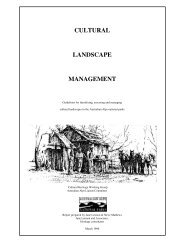The Population Ecology of Wild Horses in the Australian Alps
The Population Ecology of Wild Horses in the Australian Alps
The Population Ecology of Wild Horses in the Australian Alps
Create successful ePaper yourself
Turn your PDF publications into a flip-book with our unique Google optimized e-Paper software.
Table 3: Summary <strong>of</strong> key demographic variables for <strong>the</strong> three study sites 1999-2001.<br />
Fecundity is half juveniles per adult female per year, survival rates are annual, and rate<br />
<strong>of</strong> <strong>in</strong>crease (λ) is <strong>the</strong> annual f<strong>in</strong>ite growth rate (with coefficient <strong>of</strong> variation <strong>in</strong> <strong>the</strong><br />
estimate).<br />
Site Average Fecundity Survival 0-3 Adult Rate <strong>of</strong> <strong>in</strong>crease<br />
density years survival (CV %)<br />
(horseskm -2 )<br />
Big Boggy 2.01 0.24 0.75 0.91 1.07 (3.5)<br />
Cowombat 6.40 0.21 0.63 0.91 1.03 (3.4)<br />
Currango 2.13 0.31 0.67 0.91 1.09 (4.2)<br />
<strong>Horses</strong> at Cowombat had <strong>the</strong> poorest average body condition <strong>of</strong> <strong>the</strong> three sites, and<br />
horses at Currango had <strong>the</strong> highest body condition score. This trend <strong>of</strong> body condition<br />
was reflected <strong>in</strong> <strong>the</strong> trend <strong>in</strong> food available (Table 4). <strong>The</strong> body condition <strong>of</strong> females was<br />
poorer than males, overall however, <strong>the</strong> body condition <strong>of</strong> females at Currango was not<br />
significantly different to that <strong>of</strong> males.<br />
Currango<br />
Body Con ditio n<br />
Cowombat<br />
Big Boggy<br />
Food Available<br />
Figure 3: Average body condition scores and food availability scores for <strong>the</strong> three study<br />
sites between 1999 and 2001.<br />
<strong>The</strong> trend <strong>in</strong> body condition and food availability (Figure 3) and rate <strong>of</strong> <strong>in</strong>crease (Table<br />
3) across <strong>the</strong> three sites suggests that <strong>the</strong> population at Cowombat is food limited and<br />
relatively stable while <strong>the</strong> population at Currango is not limited by food and <strong>in</strong>creas<strong>in</strong>g.<br />
<strong>The</strong> Big Boggy is <strong>in</strong> between <strong>the</strong> two. <strong>The</strong> implications <strong>of</strong> this for management is that<br />
<strong>the</strong> Currango population is likely to cont<strong>in</strong>ue to <strong>in</strong>crease if no control actions are taken,<br />
although <strong>the</strong> relative impact <strong>of</strong> <strong>the</strong> horses at Currango on vegetation is lower. At <strong>the</strong><br />
o<strong>the</strong>r end <strong>of</strong> <strong>the</strong> scale, <strong>the</strong> population at Cowombat appears to be stable and <strong>in</strong><br />
equilibrium with its environment and unlikely to <strong>in</strong>crease <strong>in</strong> size <strong>in</strong> <strong>the</strong> absence <strong>of</strong><br />
management, although <strong>the</strong> impact <strong>of</strong> <strong>the</strong> wild horses <strong>in</strong> <strong>the</strong> area on <strong>the</strong> vegetation is<br />
higher. <strong>The</strong> Cowombat site was burnt by <strong>in</strong>tense wildfire <strong>in</strong> 2003 and it would be<br />
beneficial to revisit <strong>the</strong> sites to reassess <strong>the</strong> populations.<br />
10

















